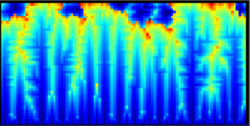Lab-0011
From CSDMS
Quantifying river channel evolution with Landlab
Contributor(s)
Nicole Gasparini at Tulane University.
Classroom organization
Answer these questions before running the notebook.
1. What do you think will happen to total relief (defined as the maximum minus the minimum elevation, here area is fixed) and channel slope at steady state if $K_{sp}$ is uniformly increased?
2. What do you think will happen to total relief and channel slope at steady state if $U$ is uniformly increased?
3. How do you think a steady-state landscape with a uniform low rock uplift rate will respond if rock uplift is uniformly increased (relative to a steady base level)? How will channel slopes change through time?Learning objectives
Skills
Skills
Key concepts
Lab notes
Start at the top by reading each block of text and sequentially running each code block (shift - enter OR got to the Cell pulldown menu at the top and choose Run Cells). If you just change one code block and rerun only that code block, only the parts of the code in that code block will be updated. (E.g. if you change parameters but don't reset the code blocks that initialize run time or topography, then these values will not be reset.)
References

